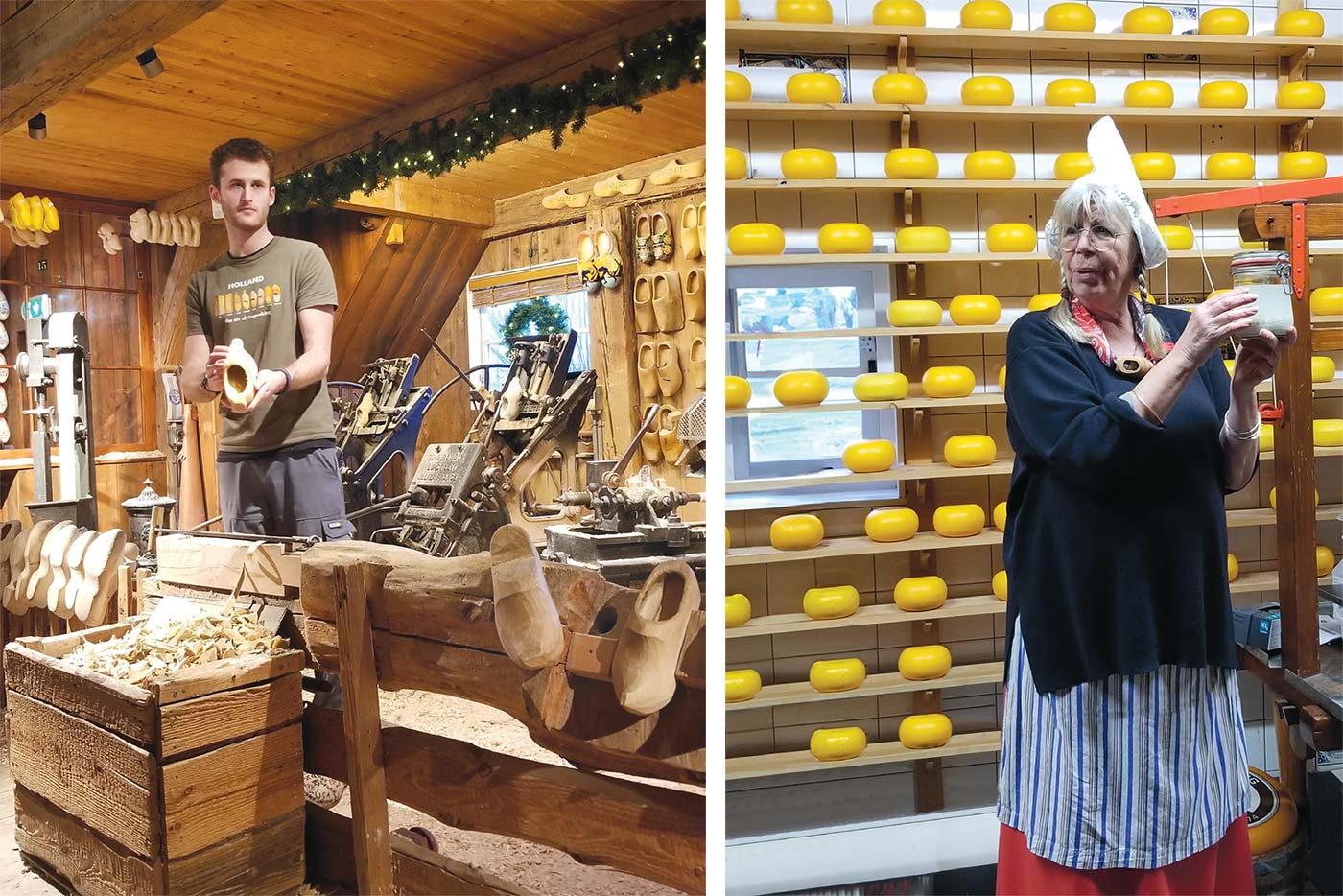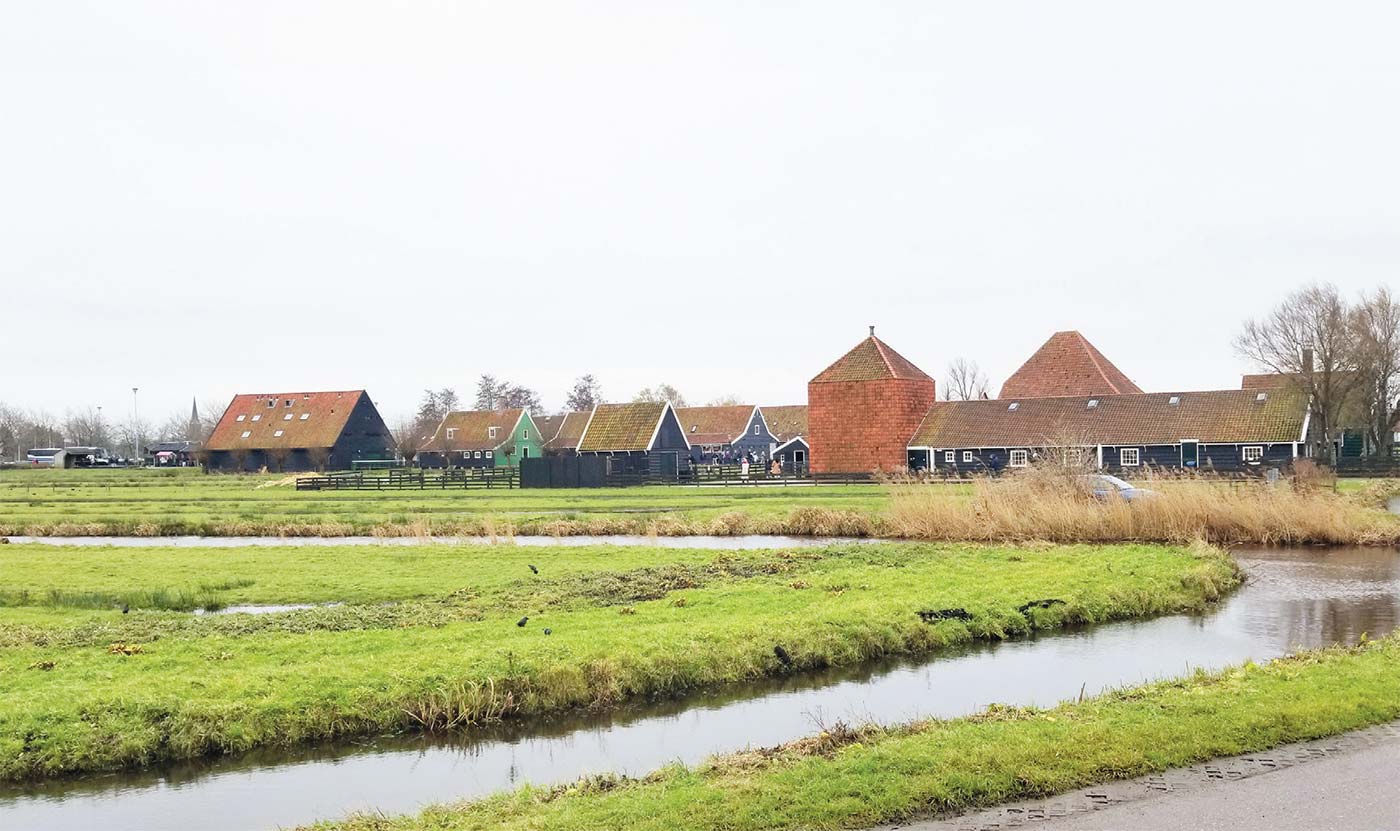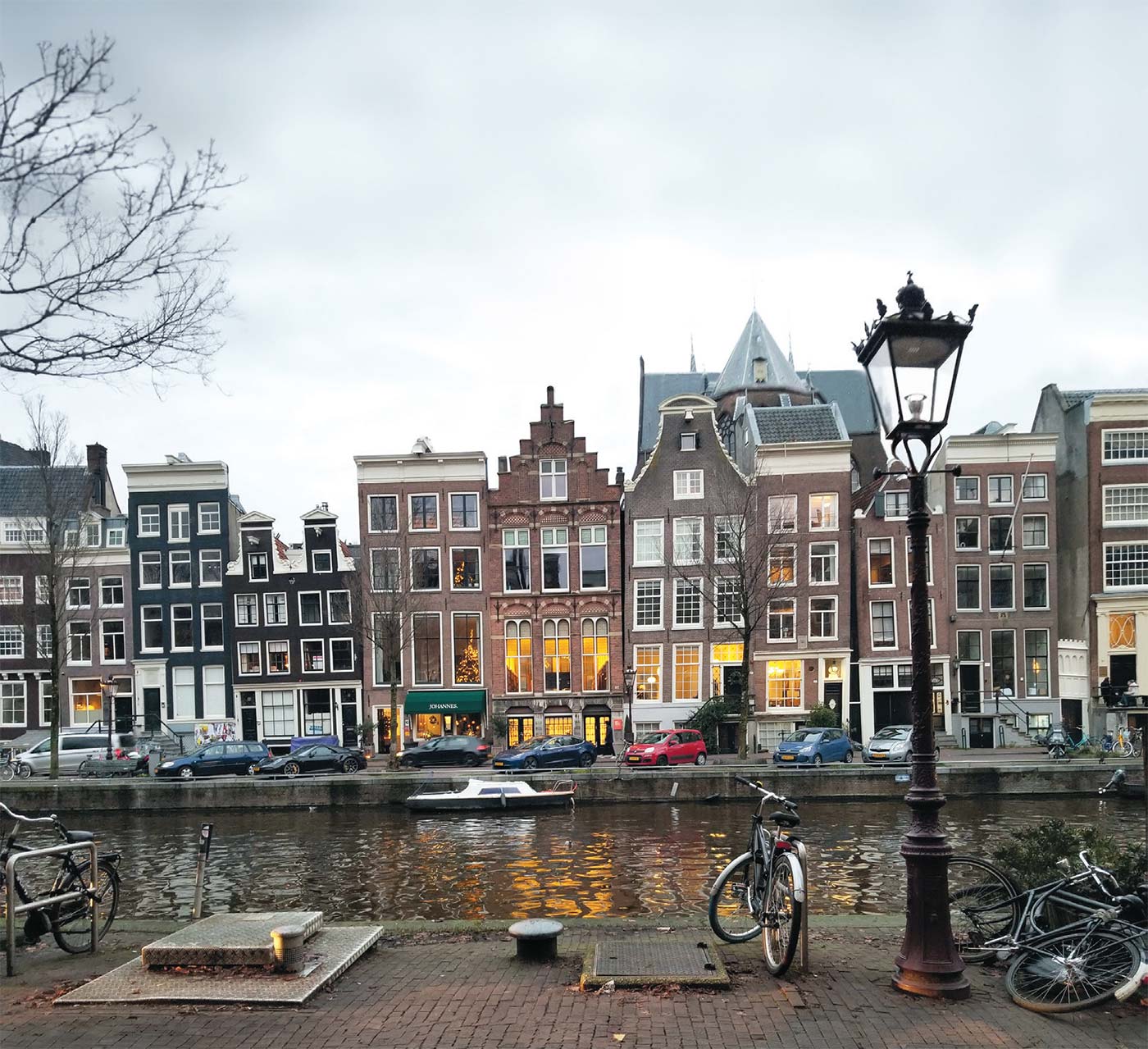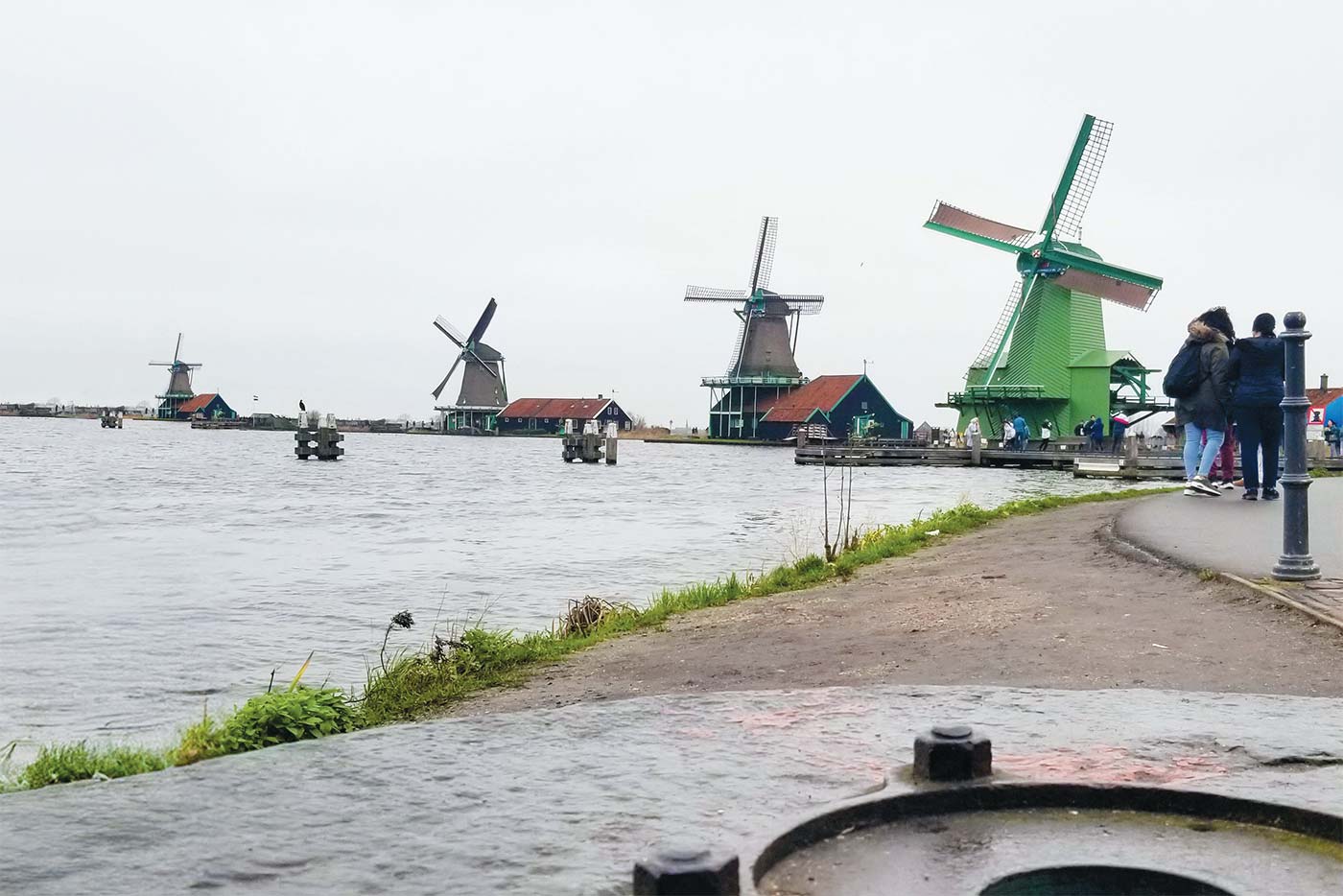Going Dutch
We went to winter markets, visited the Zaanse Schans historic district to see the windmills and wooden clogs, checked out recommended attractions, walked along centuries-old canals, gawked at the Dutch gothic-style city buildings and ate as much food as we could.
Just after magazine deliveries of our winter issue and a couple weeks before Christmas, I packed up and flew with three of my adult children (ages 18, 18 and 20) to Amsterdam in the Netherlands. We had seven days to see it all and two of those days were just traveling to and fro.
We arrived at Amsterdam Airport Schiphol early in the morning, long before we could check into our hotel. While I had read that many hotels there would hold your luggage for you, we opted instead to keep our backpacks while we visited the home of my 18-year-old son’s friend Lars, who lives 30 minutes away in the small town of Heiloo. (For reference, Heiloo is almost exactly a quarter of the population size of the City of Ventura, while Amsterdam’s population is nearly the same as all of Ventura County.)
While we could have easily traveled by train, Lars met us at the airport and drove while we gaped at the Dutch countryside and peppered him with questions about the region and its rich history. It was drizzling on and off, a state that continued for most of our time there, with temperatures that stayed in the 40s and 50s.
In Holland, drivers have to pass rigorous licensing tests that put ours to shame, and with good reason. With the excellent public transportation and bicycles as the main modes of transit, cars (many of which are much smaller than what you might find on California roads) have lower priority in the grand scheme of mobility, especially within city limits.

In the historic district of Zaanse Schans just 20 minutes outside of Amsterdam, visitors can watch and be entertained by a clog maker who shows the old and new process of making the wooden shoes. A short walk up the road, you can taste and learn about the history of Gouda cheese making.
I felt so honored to be able to see how the locals lived as it really enhanced our understanding of the Netherlands and its people. English is the most common second or third language in the area, so while we attempted to learn a bit of Dutch—pronouncing words so badly at times that Lars couldn’t contain his laughter—communication was not at all a problem anywhere we went. In fact, one of the locals told us that there are 135 ethnicities and several languages represented in the population of Amsterdam.
Once we arrived in Heiloo, Lars took us to the neighborhood grocery store to pick up a few things—a five-minute walk away—then he and his dad, who is vegetarian, set us up with lunch in their comfortable home. The food included my son’s favorite Dutch treat, commonly consumed for breakfast: toast with haglslag and pindakaas (thick chocolate sprinkles and peanut butter). There was also fresh grapes, apples and avocados, bread with local Gouda cheese and a pesto spread.
Did you know that Gouda (pronounced GHOW-duh in Dutch with the beginning sound similar to the ch in challah), originally comes from the town of Gouda in the Netherlands? Yes, we brought cheese home. No, there isn’t any left.
Drinks were a local sweet juice that was meant to be cut with sparkling water and water from the tap—the Dutch are very proud that their water is considered some of the cleanest in Europe, checked daily in a lab and with an average pH of 8.06.
After lunch, we hitched another ride with Lars back to the city so our touristy time could begin, leaving my son to stay local with his buddy’s family for the night.
We stayed at the Citiez Hotel Amsterdam West. It’s about 6 km or 20 minutes from the city center via tram, which we could grab 100 steps from the hotel entrance. There are plenty of hotels closer to Central Station, some surrounded by cheese shops and quaint alleyways and open city squares. As an international hot spot, Amsterdam’s hotel options, from location to level of luxury, are nearly endless.
Over the next five days, we went to winter markets, visited the Zaanse Schans historic district to see the windmills and wooden clogs, checked out recommended attractions (“This is Holland” was completely worth it and free with our city card pass), walked along centuries-old canals, gawked at the Dutch gothic-style city buildings and ate as much food as we could.
Was there more we wanted to see? So much. Would we go back? In a heartbeat. In fact, I would really like to see the country in a different season, to experience the tulips in bloom and some of the museums that were closed while we were there.

1. Food trucks are not foreign to Amsterdam. In fact, in May, the city celebrates the rolling kitchens with a festival.
2. The aptly named Centraal Station is not just central to the city center and the heart of the historic district, but also a major port of public transportation including everything from trains and buses to ferries and tourist boats.
3. A sustainable farm style house in Heiloo, just 30 minutes from Amsterdam. A neighbor tells us that the thatched roof only needs upkeep about every few years, but it should last 30–50 years.
4. Dating back to the 1600s, the 100km (around 60 miles) of iconic canals in Amsterdam were originally built for water management and defense and are now still valuable transportation pathways.
5. Bikes are everywhere in Amsterdam with designated bike roads that often take right of way over cars and pedestrians. This is a typical alleyway in the historic area.
6. The House of Bols is a fun tourist experience to learn about the Genever spirits made from a 400-year-old recipe and experience the sights and smells of its creation.
7. The 5D experience called “This is Holland” was recommended by a local and is well worth the time. While you are waiting for your entry time, stop by The Coffee Lab, an espresso bar inside the neighboring school with beans roasted sweet, sour or bitter.
TIPS TO MAKE YOUR AMSTERDAM TRIP AMAZING
- First step: If you don’t already have a passport, allow for about six months to obtain it, just in case anything goes wrong. A passport also works in lieu of a RealID, in case you haven’t upgraded yet. There is not really a downside to having a passport in hand, especially if there is any travel in your future.
- Prepping ahead: Make sure to bring plenty of cash (euros) since some places in Amsterdam do not accept credit cards. Our first night, we just needed to grab some fresh fruit and vegetables to assist in combating the jet lag and found that the supermarkets don’t take cards. Cash it is.
- Helpful hint here: Most banks will do a currency exchange at the current exchange rate without extra cost or fees for their own customers. Make sure to plan ahead though; most banks don’t have euros on hand and it can take up to two weeks after you order.
- Be ready to walk a lot. Starting off in the massive airport (seriously, with the amount of shops and eateries inside, you could spend an entire day meandering and never see the same place twice), we easily got our 10K steps on the first day, just strolling around the block.
- To really get a tourist experience try either the Go City Pass or the I Amsterdam City Card available for purchase online ahead of time or once you have arrived. This allows access to most of the city’s museums and discounts on some fun attractions such as canal and river cruises, “This is Holland” 5D experience, Old Holland tours, food tours, Bols cocktail tour, bike rentals and more.
- As I mentioned, Amsterdam has excellent public transportation which consists of trains, trams, buses and ferries. The I Amsterdam City Card includes access to most of the city’s public transportation. To travel in and out of the city, especially to visit more of the nearby towns and attractions, the Amsterdam & Region Travel Ticket is the better purchase. For more information on both options, scan the code below.

WHEN TO TRAVEL TO AMSTERDAM
March is the beginning of the tulips. Traditionally, when we think of Holland, the windmills, wooden clogs and tulips are the first images that rise. Late March to early May are a great time to see the tulips in nearby Keukenhof—home of 7 million flowering bulbs—as well as to visit some of the more serious and reflective destinations like the National Holocaust Museum, which opens in March.
July is beach weather in the Netherlands and while there is no shortage of beaches, there is also no shortage of tourists on those beaches. Summer is always a high season for travel so there may be a bit more traffic at some of the more attractive attractions.
December is a time of winter markets and Christmas lights, so if that is your thing, it is the perfect holiday trip. The weather, for the most part, is cold and a bit rainy, but won’t prevent visits to Old Holland, canal cruises and loads of museums. November and December are also popular times to visit Amsterdam, so plan ahead to get the best out of your time there. See our list for some of the best winter markets in the city.
- For food- or garden-related events to check out and dates to be aware of in 2024, visit edibleventuracounty.ediblecommunities.com/things-do/resources-amsterdam-travel-california
REDUCING JET LAG
Jet lag is a real thing and can really get in the way of enjoying your destination, especially if your trip is only a few days long. Amsterdam is nine hours “ahead” of California (PST). When arriving in the Netherlands, the body’s circadian rhythm is still adapted to the previous time zone, so 8am in Amsterdam will still feel like 11pm in your body. Symptoms of jet lag can include insomnia, daytime sleepiness, appetite and digestive dysregulation, low mood, loss of concentration and lowered alertness.
Here are some science-based tips for speeding up jet lag recovery: The body responds to zeitgebers, external cues that affect the regulation of circadian rhythm—cues like light, exercise and food. Applying these zeitgebers at the right time (based on research) can drastically reduce the symptoms of jet lag.
- Sleep: Start ahead of time! If possible, start going to bed an hour earlier each day for at least three days. Also wake up an hour earlier and expose yourself to bright light (if it is still dark outside, a light box might be a great investment).
- Light: Upon arrival, be sure to get out in the sun, especially the first morning in the new time zone.
- Exercise: Keep an exercise routine even after travel, especially in the morning of the new time zone.
- Hydration: Travel is a notorious dehydrator. Staying hydrated before, during and after significant travel can help the body adapt to the new time zone. As challenging as it might be, try to avoid caffeine and alcohol during travel. These can make the physical symptoms of jet lag worse.
- Meals: Whenever possible, switch mealtimes to the new time zone. If you are hungry but it isn’t mealtime, try a small snack or large glass of water. This can also be started ahead of time when possible. Additionally, increase pre- and probiotic foods to help with potential digestive issues.

The iconic narrow canal houses in Amsterdam date back to the 17th century when an influx of wealthy traders outweighed the city’s housing supply. The buildings were often used as both home and work, with residences on the upper floors. The roof hooks used to lift supplies and goods are still present today.
TRAVELING THE WORLD SUSTAINABLY
While in Amsterdam, I had an enlightening conversation with a local geology teacher who had decided that he had done more than enough air travel in his life and to do more would be irresponsible from a carbon footprint perspective. He and his wife still traveled around Europe, but it was by bicycle for the most part. His only regret in his choice seemed to be that he would not be able to see the Grand Canyon in person.
Tips to keep your travel more sustainable:
Buy a reusable bottle at the airport, or bring an empty water bottle, and refill it often on your trip.
Pack lighter. We bought travel backpacks and packed strategically so that we only had a carryon each.
Fly economy whenever possible. The less room you take on a plane, the smaller the carbon footprint.
Use public transportation locally whenever possible.
Eat locally. Local food made by local vendors has a smaller carbon cost.
Stay in eco-friendly hotels. Amsterdam is very eco-conscious, so while there may be a “Best of” list out there, many of the hotels have energy savings and low-waste procedures already in place.
Do only one long flight or international trip per year and keep your home life as waste free as possible as a balance.
Use the Curb6 carbon footprint calculator to determine the carbon cost of your trip: Curb6.com.
Offset your travel by supporting projects that reduce emissions: SustainableTravel.org.




